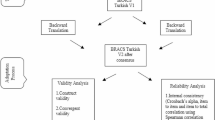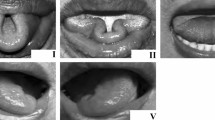Abstract
We tested the Voice Handicap Index (VHI) in 45 patients with substitution voicing (that is, without the use of two vocal folds), the majority of them using tracheo-oesophageal speech. We introduced a corrected VHI score (VHIcorr) whose values are in the range from 0 to 100 and which can be expressed as a percentage. As such, the VHIcorr is a handy and transparent tool, and it seems to be suited for representing the handicap caused by the voice disorder when some items are unanswered as experienced in patients with substitution voicing. Interestingly, our data reveal that the voice handicap severity of this particular category of patients is (1) moderate and in the range of “common” dysphonia and (2) not affected by additional radiotherapy. It seems that the E domain is overstated due to the number of problematic items in the P and F domains.


Similar content being viewed by others
References
Rosen CA, Murry T, Zinn A, Zullo T, Sonbolian M (2000) Voice Handicap Index change following treatment of voice disorders. J Voice 14:619–623
Benninger MS, Ahuja AS, Gardner G, Grywalski C (1998) Assessing outcomes for dysphonic patients. J Voice 12:540–550
Murry T, Rosen CA (2001) Occupational voice disorders and the Voice Handicap Index. In: Dejonckere PH (ed) Occupational voice—care and cure. Kugler, The Hague, pp 113–128
Courey MS, Garrett CG, Billante CR, Stone RE, Portell MD, Smith TL, Netterville JL (2000) Outcomes assessment following treatment of spasmodic dysphonia with botulinum toxin. Ann Otol Rhinol Laryngol 109:819–822
Benninger MS, Gardner G, Grywalski C (2001) Outcomes of botulinum toxin treatment for patients with spasmodic dysphonia. Arch Otolaryngol Head Neck Surgery 127:1083–1085
Debruyne F, Delaere P, Wouters J, Uwents P (1994) Acoustic analysis of tracheo-esopahgeal versus esophageal speech. J Laryngol Otol 108:325–328
Crevier-Buchman L, Laccourreye O, Papon JF, Monfrais-Pfauwadel MC, Brasnu D (1996) Apports et limites de l’analyse acoustique de la voix et de la parole alaryngée au moyen d’un système informatique. Ann Otolaryngol Chir Cervicofac 113:61–68
Robbins J, Fisher HB, Blom EC, Singer MI (1984) A comparative study of normal, esophageal and tracheoesophageal speech production. J Speech Hearing Disorders 49:202–210
Stewart MG, Chen AY, Stach CB (1998) Outcomes analysis of voice and quality of life in patients with laryngeal cancer. Arch Otolaryngol Head Neck Surg 124:143–148
Moerman M, Pieters G, Martens JP, Van der Borght MJ, Dejonckere P (2003) Objective evaluation of substitution voices. Eur Arch ORL (accepted for publication)
De Bodt M, Jacobson B, Musschoot S, Zaman S, Heylen L, Mertens F, Van de Heyning P, Wuyts F (2001) De Voice Handicap Index. Logopedie en Foniatrie 73:159–162
Moerman MB, Fahimi H, Voet D (2003) Secondary placement of a voice prosthesis after earlier total pharyngolaryngectomy with colon interposition. Eur Arch ORL 260:7–8
Jacobson BH, Johnson A, Grywalski C, Silbergleit A, Jacobson G, Benniger MS, Newman CW (1997) The voice handicap index (VHI): development and validation. Am J Speech Lang Pathol 6:66–70
Hartnick CJ (2002) Validation of a pediatric voice quality of life instrument (the pediatric “voice outcome survey”). Arch Otolaryngol Head Neck Surg 128:919–922
Author information
Authors and Affiliations
Corresponding author
Rights and permissions
About this article
Cite this article
Moerman, M., Martens, JP. & Dejonckere, P. Application of the Voice Handicap Index in 45 patients with substitution voicing after total laryngectomy. Eur Arch Otorhinolaryngol 261, 423–428 (2004). https://doi.org/10.1007/s00405-003-0683-y
Received:
Accepted:
Published:
Issue Date:
DOI: https://doi.org/10.1007/s00405-003-0683-y




